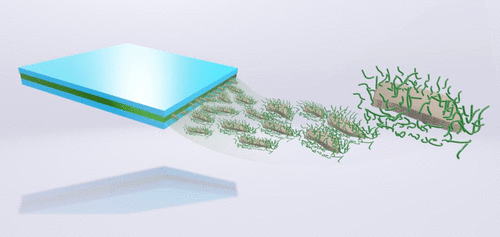当前位置:
X-MOL 学术
›
ACS Appl. Electron. Mater.
›
论文详情
Our official English website, www.x-mol.net, welcomes your
feedback! (Note: you will need to create a separate account there.)
Strategy of Fabricating Flexible Strain Sensor via Layer-by-Layer Assembly of Conductive Hydrogels
ACS Applied Electronic Materials ( IF 4.3 ) Pub Date : 2021-09-02 , DOI: 10.1021/acsaelm.1c00484 Yao Chen 1, 2 , Xie Fu 2, 3 , Shuai Kang 2 , Liang Wang 2 , Wenqiang Lu 2
ACS Applied Electronic Materials ( IF 4.3 ) Pub Date : 2021-09-02 , DOI: 10.1021/acsaelm.1c00484 Yao Chen 1, 2 , Xie Fu 2, 3 , Shuai Kang 2 , Liang Wang 2 , Wenqiang Lu 2
Affiliation

|
Conductive hydrogels are widely used in flexible strain sensors for their excellent performance. However, problems, such as the incompatibility of the conductive structure and flexible domain and the poor interfacial adhesion between the conductive materials and the soft substrates, limit their application in large deformation sensing response. Layer-by-layer (LbL) assembly technology provides a strategy to control and design the composite structure. On the basis of the LbL assembly technique, a flexible strain sensor with a “hydrogels–conductive materials–hydrogels” hierarchical sandwich structure was prepared in this work. Poly(vinyl alcohol) (PVA)/polyvinylpyrrolidone (PVP) was used as a raw material to prepare hydrogel skeleton materials, and conductive materials were prepared by the combination of doped polyaniline (PANI) acid and MXenes (Ti3C2Tx). Introduction of MXene materials into flexible sensors could significantly improve the sensitivity (K). When the MXene contents are 5%, the Kmax of the flexible sensor reaches 5.88. This typical sandwich-like structure strain sensor could withstand various forms of deformation (∼1000% strain) and stress (bending, twisting, folding, compression, stretching), which has potential application in human-activity monitoring, such as finger bending, wrist bending, heeling pressing, phonation recognition, etc.
中文翻译:

通过导电水凝胶的逐层组装制造柔性应变传感器的策略
导电水凝胶因其优异的性能被广泛用于柔性应变传感器。然而,诸如导电结构和柔性域的不相容性以及导电材料与软基板之间的界面粘附性差等问题限制了它们在大变形传感响应中的应用。逐层 (LbL) 组装技术提供了一种控制和设计复合结构的策略。在LbL组装技术的基础上,本文制备了一种具有“水凝胶-导电材料-水凝胶”分层夹层结构的柔性应变传感器。以聚乙烯醇(PVA)/聚乙烯吡咯烷酮(PVP)为原料制备水凝胶骨架材料,通过掺杂聚苯胺(PANI)酸和MXenes(Ti3C2Tx)的组合制备导电材料。将 MXene 材料引入柔性传感器可以显着提高灵敏度(克)。当MXene含量为5%时,柔性传感器的K max达到5.88。这种典型的三明治状结构应变传感器可以承受各种形式的变形(~1000% 应变)和应力(弯曲、扭曲、折叠、压缩、拉伸),在人类活动监测中具有潜在的应用,例如手指弯曲、手腕弯腰、压跟、发声识别等。
更新日期:2021-09-28
中文翻译:

通过导电水凝胶的逐层组装制造柔性应变传感器的策略
导电水凝胶因其优异的性能被广泛用于柔性应变传感器。然而,诸如导电结构和柔性域的不相容性以及导电材料与软基板之间的界面粘附性差等问题限制了它们在大变形传感响应中的应用。逐层 (LbL) 组装技术提供了一种控制和设计复合结构的策略。在LbL组装技术的基础上,本文制备了一种具有“水凝胶-导电材料-水凝胶”分层夹层结构的柔性应变传感器。以聚乙烯醇(PVA)/聚乙烯吡咯烷酮(PVP)为原料制备水凝胶骨架材料,通过掺杂聚苯胺(PANI)酸和MXenes(Ti3C2Tx)的组合制备导电材料。将 MXene 材料引入柔性传感器可以显着提高灵敏度(克)。当MXene含量为5%时,柔性传感器的K max达到5.88。这种典型的三明治状结构应变传感器可以承受各种形式的变形(~1000% 应变)和应力(弯曲、扭曲、折叠、压缩、拉伸),在人类活动监测中具有潜在的应用,例如手指弯曲、手腕弯腰、压跟、发声识别等。











































 京公网安备 11010802027423号
京公网安备 11010802027423号